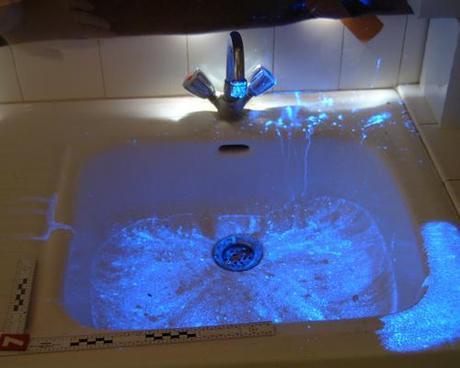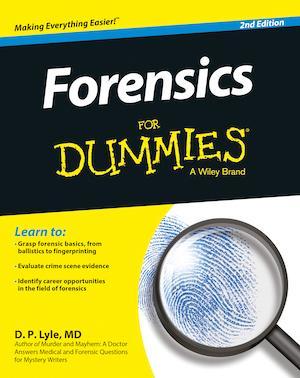
Sometimes blood shed at a crime scene is easily visible but at other times less so. Maybe it's a very small amount, or perhaps soaked into a patterned carpet, or secreted in the gaps between tiles and baseboards. Perhaps the killer has cleaned up the crime scene, thinking that if the blood is not visible, it's not findable. Maybe he even washed the blood off is hands and watched it circle down the drain. Gone forever.
Or maybe not. Things such as luminol can uncover these hidden stains.
Luminol is actually quite sensitive for finding blood. Spraying it on a wall that has been wiped clean of visible blood, or often even if painted over, and then turning out the lights will reveal the glowing pattern of the blood splatter. This helps not only to locate the blood but also to identify patterns, which, in turn, might help re-create the crime scene. Such reconstructions are critical in bloody homicide investigations.
From FORENSICS FOR DUMMIES: Reconstructing the crime scene from bloodstains Contaminated evidence is no evidence at all, so investigators have to document bloodstain and spatter patterns in a timely and logical fashion. Police, fire, and rescue personnel can alter or contaminate the blood evidence, as can any unnecessary foot traffic at the crime scene. For that reason, investigators need to take control of the scene immediately and consistently. Unless they're high‐traffic public places, indoor scenes usually can be preserved long enough for investigators to obtain needed information. Outdoor scenes, however, are subject to environmental influences, and public places require investigators to gather information more urgently. Investigators carefully photograph bloodstains. Initial photographs capture an overall view of the scene. Subsequent pictures gradually move in on individual stains. The photographer takes pictures of individual stains close enough to reveal all needed detail, and should include a ruler or other measuring device to provide a scale reference. In homicide cases, investigators check out the body and any associated bloodstains or spatter first. After the body is removed, investigators turn their attention to other spatters. Some bloodstains are latent (invisible to the naked eye). Investigators often use luminol to expose these hidden stains. Luminol is a chemical that reacts with the hemoglobin in blood to produce a complex substance that luminesces (glows). Luminol is extremely sensitive, detecting blood in concentrations as low as one part per million. Investigators darken the room and spray luminol over areas where they suspect blood to be. When blood is present, stains glow a bluish‐white, and the photographer takes pictures of the glowing pattern. Luminol also can reveal bloody tracks that indicate the perpetrator's movements or escape route and drag marks that show whether anyone moved the body. Luminol is so sensitive that it can uncover blood in cracks, crevices, and even areas where someone has tried to clean it. It's important to note that many substances can interfere with or confuse luminol pattern analysis. Bleach and other cleaning agents, certain paints and varnishes, and even some fruit juices are examples. After photographers take an adequate number and variety of photographs, crime‐scene analysts complete their analyses and create a report that may include implications of the victim's and assailant's locations at each stage of the crime, the number and types of injuries inflicted, and the exact sequence of events (see the next section to understand how analysts gather this information).But, as mentioned above, there are things that interfere with this chemical process. Certain fruit juices, bleaches, horseradish and turnips, and other chemicals will also react with luminol and this can confuse the issue.
A recent study reported in Science Daily suggests that a new method might help solve some of these problems. Combining luminol with the antimalarial drug Artemisinin seems to reduce this cross-reactivity and therefore more specifically display the true blood spatter pattern. Obviously, more research is needed, but this is a potentially useful tool.

